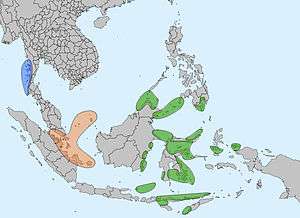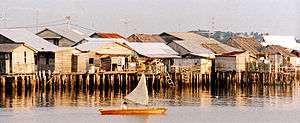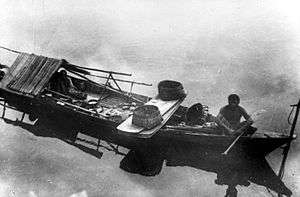Orang laut
|
An Orang Laut family living in a boat, circa 1914–1921. | |
| Regions with significant populations | |
|---|---|
| Andaman Archipelago, Peninsular Malaysia, Riau Archipelago, Singapore | |
| Languages | |
| Malay language (Orang Laut dialect) | |
| Religion | |
| Islam, Animism | |
| Related ethnic groups | |
| Malay people, Moken, Urak Lawoi’ people |

The Orang Laut are a group of Malay people living around Singapore, peninsular Malaysia and the Riau Islands. It also may refer to any Malay origin people living on coastal islands, including those of Andaman Sea islands of Thailand and Burma, commonly known as Moken.
Etymology
The Malay term orang laut literally means the sea peoples. The Orang laut live and travel in their boats on the sea.[2] Another Malay term for them, Orang Selat (literally Straits People), was brought into European languages as Celates.
Distribution
Broadly speaking, the term encompasses the numerous tribes and groups inhabiting the islands and estuaries in the Riau-Lingga Archipelagos, the Pulau Tujuh Islands, the Batam Archipelago, and the coasts and offshore islands of eastern Sumatra, southern Malaysia Peninsula and Singapore.[3]
History


Historically, the orang laut played major roles in Srivijaya, the Sultanate of Malacca, and the Sultanate of Johor. They patrolled the adjacent sea areas, repelling real pirates, directing traders to their employers' ports and maintaining those ports' dominance in the area.[4]
Popular Culture
In the story "The Disturber of Traffic" by Rudyard Kipling, a character called Fenwick misrenders the Orang laut as "Orange-Lord" and the narrator character corrects him that they are the "Orang-Laut".
See also
References
- ↑ David E. Sopher (1965). "The Sea Nomads: A Study Based on the Literature of the Maritime Boat People of Southeast Asia". Memoirs of the National Museum. 5: 389–403. doi:10.2307/2051635.
- ↑ Adriaan J. Barnouw (February 1946). "Cross Currents of Culture in Indonesia". The Far Eastern Quarterly. The Far Eastern Quarterly, Vol. 5, No. 2. 5 (2): 143–151. doi:10.2307/2049739. JSTOR 2049739.
- ↑ "The Malay Peninsula and Archipelago 1511–1722" The Encyclopedia of World History 2001;
- ↑ Mary Somers Heidhues. Southeast Asia: A Concise History. London: Hudson and Thames, 2000. Page 27
External links
| Wikimedia Commons has media related to Orang Laut. |
